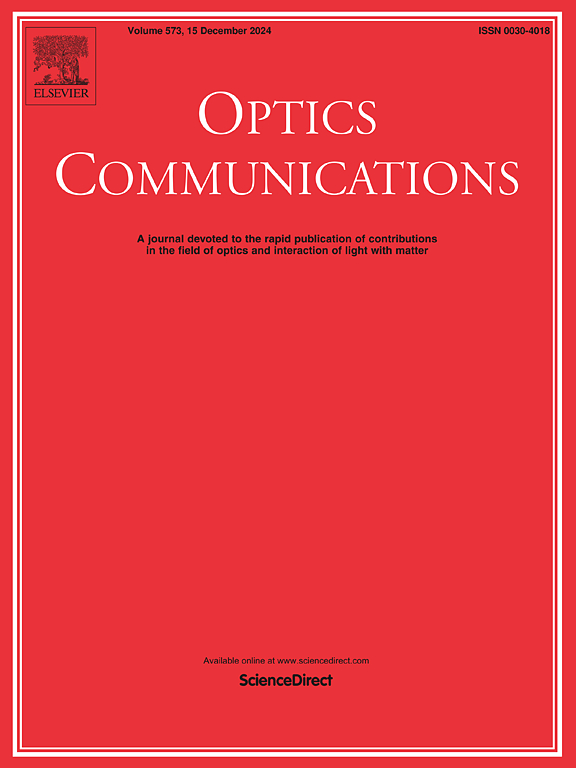基于光学IRS辅助多用户MISO波束形成的室内可见光通信系统的频谱效率优化
IF 2.5
3区 物理与天体物理
Q2 OPTICS
引用次数: 0
摘要
为了提高光学智能反射面(OIRS)辅助多用户多输入单输出(MISO)波束形成的室内可见光通信(VLC)系统的性能,提出了一种新的光谱效率(SE)优化方案。具体而言,通过联合优化发射波束形成(BF)和OIRS分配,制定了一个整体SE最大化问题,该问题受每个用户的通信服务质量(QoS)要求、OIRS配置约束和发光二极管(led)的直流(DC)偏置约束的约束。为了解决这一公式化的非凸问题,将原问题分解为传输BF和OIRS分配子问题,分别通过变量变换和一阶Taylor展开进行变换,然后提出基于逐次凸逼近(SCA)的半定松弛(SDR)算法和基于逐次凸逼近(SCA)的松弛贪婪算法分别求解这两个变换后的子问题。然后,采用交替优化(AO)算法交替求解子问题,直至收敛。仿真结果表明,在噪声功率为10 ~ 10 W的情况下,与基于位置辅助内点(LIP)算法的OIRS分配方案、距离贪心OIRS分配方案、随机OIRS分配方案和无OIRS分配方案相比,该方案在48个OIRS单元下的总体SE分别提高了约4.24、4.19、3.74和2.70 bps/Hz。这项工作将有利于室内VLC系统的研究和发展。本文章由计算机程序翻译,如有差异,请以英文原文为准。
Spectral efficiency optimization for optical IRS assisted multi-user MISO beamforming-based indoor visible light communication systems
In this work, a novel spectral efficiency (SE) optimization scheme has been proposed to improve the performance of the optical intelligent reflective surface (OIRS) assisted multi-user multi-input single-output (MISO) beamforming-based indoor visible light communication (VLC) system. Specifically, by jointly optimizing the transmit beamforming (BF) and OIRS assignment, an overall SE maximization problem has been formulated, which is subject to the communication quality of service (QoS) requirement for each user, OIRS configuration constraints, and the direct current (DC) bias constraints of the light-emitting diodes (LEDs). In order to tackle this formulated non-convex problem, the original problem is decomposed into the transmit BF and OIRS assignment sub-problems, which are transformed by variable transformations and first-order Taylor expansions, and then the successive convex approximation (SCA)-based semidefinite relaxation (SDR) algorithm and the SCA-based relaxed greedy algorithm are proposed to solve these two transformed sub-problems, respectively. Subsequently, the alternating optimization (AO) algorithm is adopted to solve the sub-problems alternatively until convergence. Simulation results demonstrate that for 48 OIRS units, the proposed scheme could improve the overall SE by approximately 4.24 bps/Hz, 4.19 bps/Hz, 3.74 bps/Hz and 2.70 bps/Hz, respectively, compared to that of the location-assisted interior-point (LIP) algorithm-based OIRS assignment scheme, the distance-greedy OIRS assignment scheme, the random OIRS assignment scheme and the scheme without OIRS under the noise power of W. This work will benefit the research and development of indoor VLC systems.
求助全文
通过发布文献求助,成功后即可免费获取论文全文。
去求助
来源期刊

Optics Communications
物理-光学
CiteScore
5.10
自引率
8.30%
发文量
681
审稿时长
38 days
期刊介绍:
Optics Communications invites original and timely contributions containing new results in various fields of optics and photonics. The journal considers theoretical and experimental research in areas ranging from the fundamental properties of light to technological applications. Topics covered include classical and quantum optics, optical physics and light-matter interactions, lasers, imaging, guided-wave optics and optical information processing. Manuscripts should offer clear evidence of novelty and significance. Papers concentrating on mathematical and computational issues, with limited connection to optics, are not suitable for publication in the Journal. Similarly, small technical advances, or papers concerned only with engineering applications or issues of materials science fall outside the journal scope.
 求助内容:
求助内容: 应助结果提醒方式:
应助结果提醒方式:


